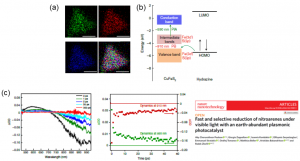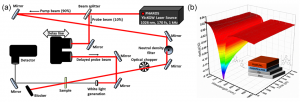Ultrafast Laser Time-Resolved Transient Absorption Spectroscopy and Diagnostics
Objective: The objective of this activity is the application of ultrafast laser time-resolved spectroscopy in the fields of photovoltaics, thermoelectric polymers, and plasmonic photocatalysts towards optimizing materials performance and expanding their applications.
Abstract: In Photovoltaics: Femtosecond time-resolved Transient Absorption Spectroscopy (TAS) is used for studying the fundamental photo-physics and decay dynamics in organic photovoltaics (OPVs) and perovskite solar cells (PSCs). Namely, TAS provides important insights on the charge carrier dynamics such as electron-hole injection times and exciton recombination rates that are well known to be directly correlated with the performance of the devices. Figure 1a presents a schematic representation of TAS experimental setup, while Figure 1b depicts a typical optical density (ΔOD) spectrum of a glass/ITO/PEDOT:PSS/CH3NH3PbI3 architecture as a function of wavelength and time from which the charge carrier dynamics are revealed upon following fitting analysis. Notably, the TAS setup in ULMNP Laboratory allows the performance of measurements under dry ambient, as well as, in-situ probing at variable temperatures. This part of the research activity is implemented by a joint effort between the ULMNP Group and the Nanomaterials and Organic Electronics Group of the Center of Materials Technology and Photonics (CEMATEP) of the Hellenic Mediterranean University (HMU), headed by Prof. Emmanuel Kymakis. Our continuous mission is to provide research facilities for state-of-the-art research in the multidisciplinary field of nanotechnology and advanced electronics. In brief the activity focuses on the following:
- Exploring the effect of hole transport layer on the charge transfer, carrier trapping and hole injection dynamics within PSCs.
- In-situ monitoring of the charge carrier dynamics of CH3NH3PbI3 perovskite during crystallization process.
- Transient photo-induced bleaching relaxation dynamics in OPVs.
- Correlation of charge carrier transport dynamics with electrical measurements towards enhancing device performance and stability.
Figure 1: (a) Schematic representation of TAS experimental setup. (b) Optical density (ΔOD) transient absorption spectra of a glass/ITO/PEDOT:PSS/CH3NH3PbI3 architecture.
In Thermoelectric Polymers: Along similar lines, the application of TAS technique is expanded to thermoelectric composite polypropylene-based polymers that contain carbon nanotubes (CNTs). The latter are responsible for generating electrical current upon exposure to temperature differentials. Recent data from our Laboratory reveal that TAS is powerful technique and a figure-of-merit method to explore ultrafast phenomena and relaxation processes that take place within these CNT composite polymers, and thus, providing important information for the design and development of novel configurations with enhanced thermoelectric performance (Figure 2). The characterization of thermoelectric polymers by means of TAS are implemented within the frame of the European project InComEss. Overall, the activity targets the following:
- Correlating exciton dynamics of single and hybrid CNT composite polymers with thermoelectric performance, towards the design of advanced energy scavenging devices.

Figure 2: Correlation of exciton dynamics and lifetimes with the thermoelectric performance of polypropylene-based polymer composites containing various types of carbon nanotubes (CNTs).
In Plasmonic Photocatalysts: The key objective of employing TAS in plasmonic photocatalysts such as CuFeS2 arises from the challenge to shed light on the mechanism of their catalytic action. It was found recently that CuFeS2 nanoparticles exhibit remarkable catalytic performance in terms of selectivity, speed, yield, and recyclability when it comes to the reduction of nitroarenes into the corresponding amines. This chemical process is of enormous importance in the field of chemical industry for the cost-effective production of polymers, pharmaceuticals, agrochemicals, and dyes. As revealed by TAS the success of the CuFeS2 nanoparticles relies on the generation of hot electrons and heat in both conduction and intermediate bands, while having suitable energy band gap with hydrazine (Figure 3). The research outcome of this activity was published in Nature Nanotechnology and with respect to TAS it focuses on:
- Insights into the mechanism of action of CuFeS2 catalyst for nitroarenes reduction.

Figure 3: (a) EDS chemical mapping of CuFeS2 nanoparticles. (b) Schematic representation of energy level diagrams of CuFeS2 catalyst and hydrazine. (c) Time-resolved transient absorption spectra of the CuFeS2 catalyst showing the optical density difference (ΔOD) as a function of wavelength at various time delays, along with the corresponding transient dynamics.
Active projects: InComEss, LASERGRAPH.
Contact persons: Dr. Ioannis Konidakis, Dr. Emmanuel Stratakis.
Project members: Dr. Ioannis Konidakis, Dr. Emmanuel Stratakis.
Project members Alumni: Prof. Costas Fotakis, Dr. Kyriaki Savva, Dr. Efthymis Serpetzoglou.
Collaborators: Prof. Emmanuel Kymakis (HMU), Dr. Petra Pötschke (IPF-Dresden), Dr. Aristides Bakandritsos (UPOL).
Selected publications:
- “Change of conduction mechanism in polymer/single wall carbon nanotube composites upon introduction of ionic liquids and their investigation by transient absorption spectroscopy: implication for thermoelectric applications”, B. Krause, I. Konidakis, E. Stratakis and P. Pötschke, ACS Appl. Nano Mater. 6, 13027 (2023).
-
“Probing the carrier dynamics of polymer composites with single and hybrid carbon nanotube fillers for improved thermoelectric performance”, I. Konidakis*, B. Krause, G.H. Park, N. Pulumati, H. Reith, P. Pötschke and E. Stratakis, ACS Appl. Energy Mater. 5, 9770 (2022).
-
“Fast and selective reduction of nitroarenes under visible light with an earth‑abundant plasmonic photocatalyst”, A.C. Poulose, G. Zoppellaro, I. Konidakis, E. Serpetzoglou, E. Stratakis, O. Tomanec, M. Beller, A. Bakandritsos and R. Zbořil, Nat. Nanotechnol. 17, 485 (2022).
- “Charge carrier dynamics in different crystal phases of CH3NH3PbI3 perovskite photovoltaic active layer”, E. Serpetzoglou, I. Konidakis, G. Kourmoulakis, I. Demeridou, K. Chatzimanolis, C. Zervos, G. Kioseoglou, E. Kymakis and E. Stratakis, Opto-Electron. Sci. 1, 210005 (2022).
- “Nitrogen-doped carbon nanotube/polypropylene composites with negative Seebeck coefficient”, B. Krause, I. Konidakis, M. Arjmand, U. Sandararaj, R. Fuge, M. Liebscher, S. Hampel, M. Klaus, E. Serpetzoglou, E. Stratakis and P. Pötschke, J. Compos. Sci. 4, 14 (2020).
- “In situ monitoring of the charge carrier dynamics of CH3NH3PbI3 perovskite crystallization process”, E. Serpetzoglou, I. Konidakis, T. Maksudov, A. Panagiotopoulos, E. Kymakis and E. Stratakis, J. Mater. Chem. C 7, 12170 (2019).
- Limitations of a polymer-based hole transporting layer for application in planar inverted perovskite solar cells”, M. Petrovic, T. Maksudov, A. Panagiotopoulos, E. Serpetzoglou, I. Konidakis, M.M. Stylianakis, E. Stratakis and E. Kymakis, Nanoscale Adv. 1, 3107 (2019).
- “Improved charge carrier dynamics of CH3NH3PbI3 perovskite films synthesized by means of laser-assisted crystallization”, I. Konidakis, T. Maksudov, E. Serpetzoglou, G. Kakavelakis, E. Kymakis and E. Stratakis, ACS Appl. Energy Mater. 1, 5101 (2018).
- “α,β-Unsubstituted meso-positioning thienyl BODIPY: a promising electron deficient building block for the development of near infrared (NIR) p-type donor-acceptor (D-A) conjugated polymers”, B.M. Squeo, V.G. Gregoriou, Y. Han, A. Palma-Cando, S. Allard, E. Serpetzoglou, I. Konidakis, E. Stratakis, A. Avgeropoulos, T.D. Anthopoulos, M. Heeney, U. Scherf and C.L. Chochos, J. Mater. Chem. C 6, 4030 (2018).
- “Enhancement of the power-conversion efficiency of organic solar cells via unveiling an appropriate rational design strategy in indacenodithiophene-alt-quinoxaline π-conjugated polymers”, C.L. Chochos, R. Singh, V.G. Gregoriou, M. Kim, A. Katsouras, E. Serpetzoglou, I. Konidakis, E. Stratakis, K. Cho and A. Avgeropoulos, ACS Appl. Mater. Interfaces 10, 10236 (2018).
- “Improved carrier transport in perovskite solar cells probed by femtosecond transient absorption spectroscopy”, E. Serpetzoglou, I. Konidakis, G. Kakavelakis, T. Maksudov, E. Kymakis and E. Stratakis, ACS Appl. Mater. Interfaces 9, 43910 (2017).
- “The role of chemical structure in indacenodithienothiophene-alt-benzothiadiazole copolymers for high performance organic solar cells with improved photo-stability through minimization of burn-in loss”, C.L. Chochos, N. Leclerc, N. Gasparini, N. Zimmerman, E. Tatsi, A. Katsouras, D. Moschovas, E. Serpetzoglou, I. Konidakis, S. Fall, P. Leveque, T. Heiser, M. Spanos, V.G. Gregoriou, E. Stratakis, T. Ameri, C.J. Brabec and A. Avgeropoulos, J. Mater. Chem. A 5, 25064 (2017).


